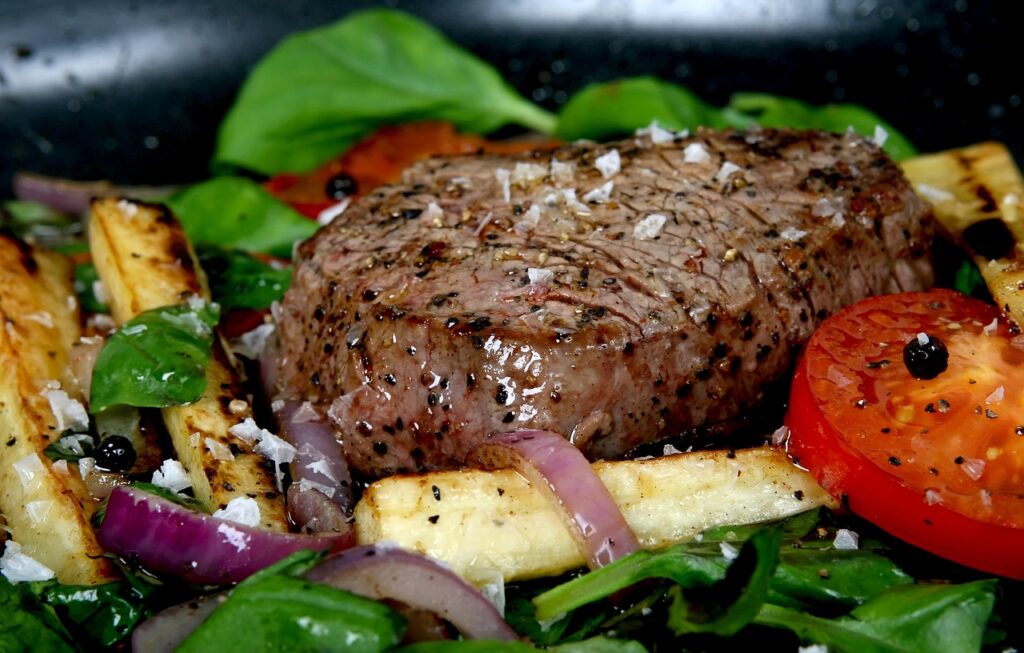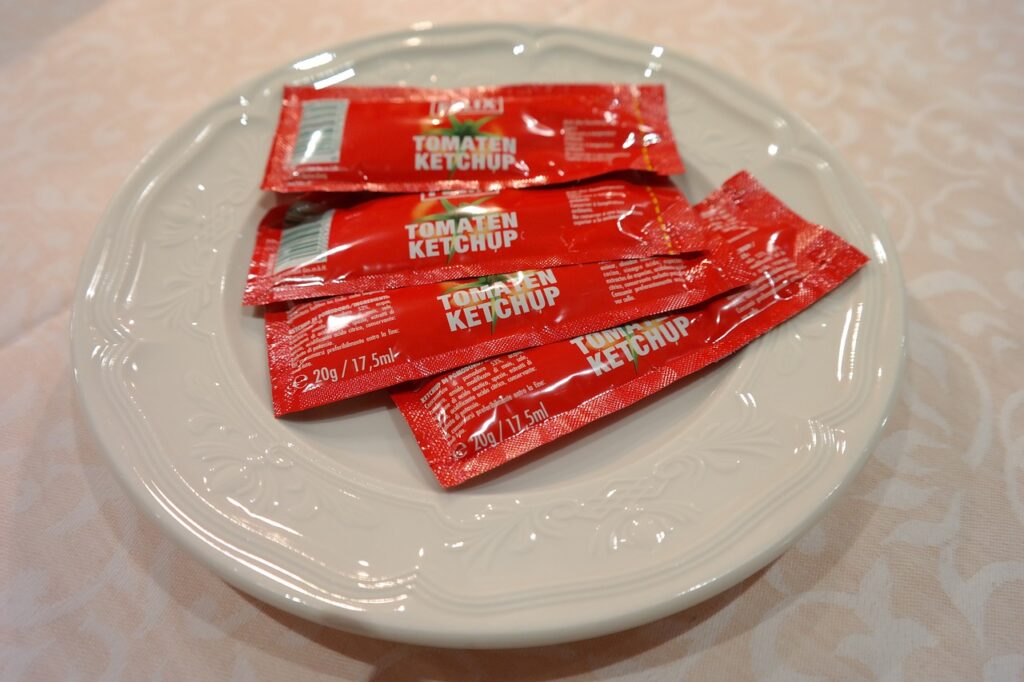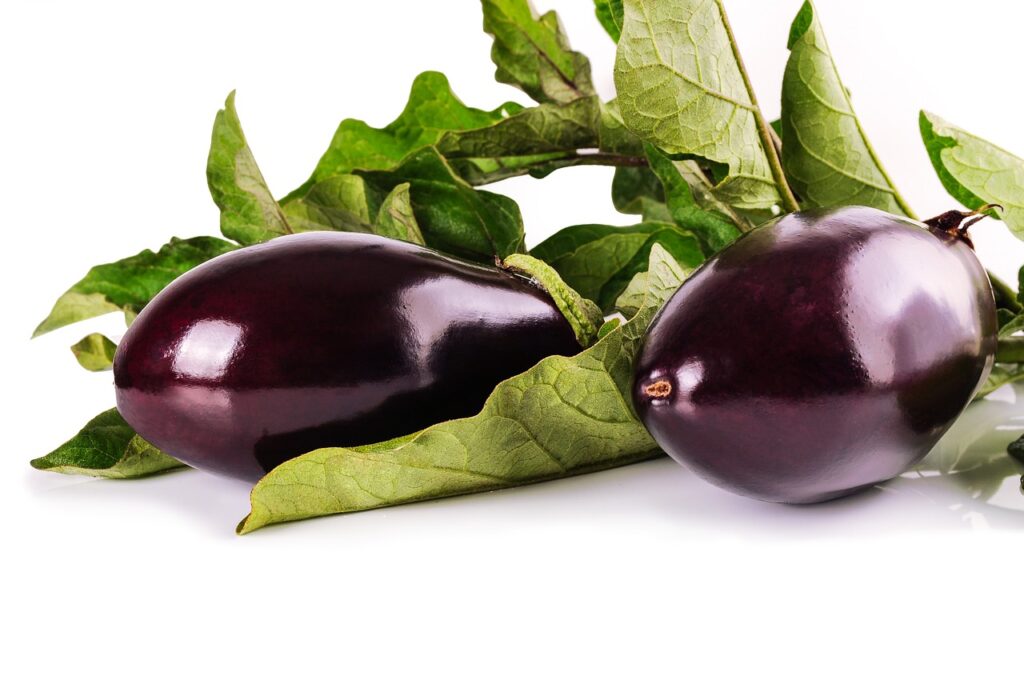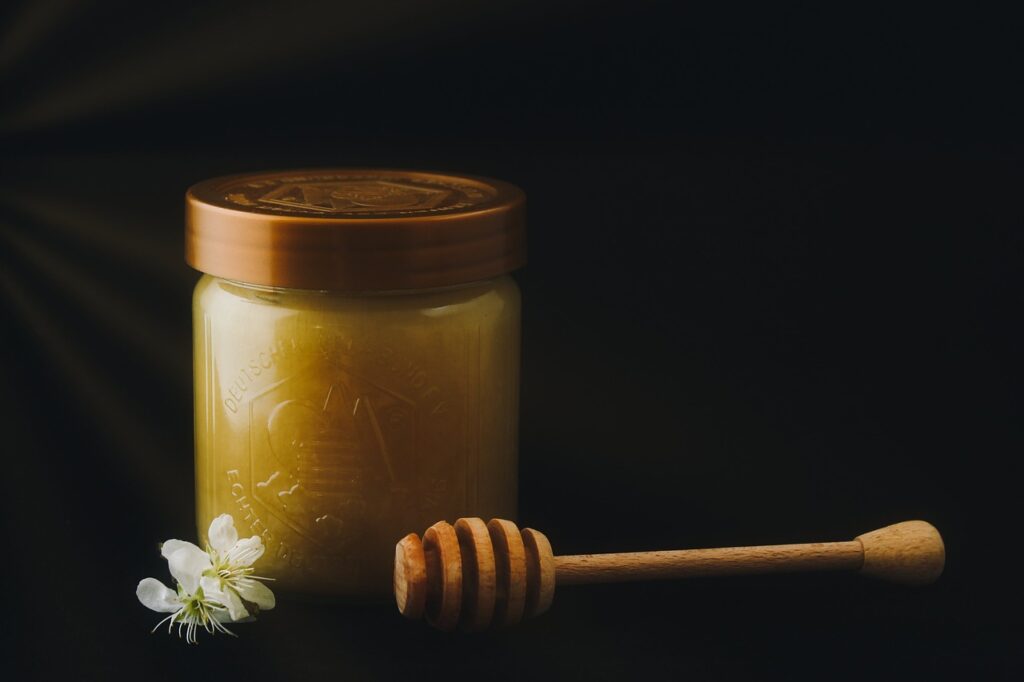If you're looking for keto rice substitutes, you've got great options! Riced cauliflower is a top choice with just 0.9 grams of net carbs per serving. Shirataki rice is another winner, offering zero calories and 0.6 grams of net carbs. Riced cabbage and broccoli rice add flavor and nutrients too, with 5.8 and 5 grams of carbs, respectively. Zucchini rice and mushroom rice keep the carb count low while adding a tasty twist. Don't overlook lentils, wild rice, and quinoa for variety, but watch the carbs! Keep exploring for more delicious substitutes that can enhance your low-carb meals!
Riced Cauliflower
Riced cauliflower is an excellent low-carb substitute for traditional rice, packing only 0.9 grams of net carbs per 50-gram serving. This makes it one of the most popular low-calorie, low-carb rice substitutes available today.
With just 24 calories per 100 grams, it's a great option if you're trying to cut down on carbs and calories. Additionally, it complements a variety of low-carb vegetables that can enhance your keto meals. Not only does riced cauliflower help you stay on track with your diet, but it also offers significant health benefits.
It's rich in essential nutrients like potassium, vitamins B6, C, K, and folate, which are crucial for overall health. You can easily prepare this versatile alternative by blending cauliflower florets until you achieve a rice-like texture. Just remember to remove excess moisture for the best results.
You'll love how riced cauliflower can be sautéed in olive oil for about 5 to 10 minutes, enhancing its nutty flavor. It pairs well with stir-fries, curries, and casseroles, serving as a nutritious base for your low-carb meals.
Shirataki Rice
If you're looking for a rice substitute with zero calories, Shirataki rice is a fantastic choice. Made from konjac plant fiber, it fits perfectly into your keto meal plans and can be used in a variety of dishes.
Additionally, it's virtually calorie-free and carb-free, making it an excellent option for those monitoring their carbohydrate intake. Its unique texture and ability to absorb flavors make it a versatile option for any recipe you want to enhance without adding extra carbs.
Nutritional Profile highlights the benefits of this alternative.
Zero-Calorie Benefits
Discovering shirataki rice can transform your low-carb meals with its impressive zero-calorie benefits. Made from konjac plant fiber, this rice substitute contains zero calories per serving, making it perfect for those following strict low-carb or keto diets. Each 50 grams of cooked shirataki rice has only 0.6 grams of net carbs, allowing you to enjoy your favorite dishes without worrying about exceeding your carb limits.
Here are a few reasons to contemplate adding shirataki rice to your meals:
- Zero calories: This rice substitute won't contribute to your daily caloric intake.
- Low carb: With just 0.6 grams of net carbs per serving, it fits seamlessly into your keto meals.
- Rich in fiber: The high fiber content promotes digestive health and keeps you feeling full longer.
- Easy to prepare: Shirataki rice requires minimal effort—just rinse and warm it up before serving.
Incorporating shirataki rice into your diet allows you to enjoy satisfying meals without the guilt, making it a valuable addition to your low-carb lifestyle.
Versatile Recipe Applications
Shirataki rice offers incredible versatility in the kitchen, allowing you to create a wide range of delicious low-carb dishes. Made from konjac plant fiber, this versatile ingredient contains zero calories and just 0.6 grams of net carbs per 50 grams cooked serving, making it an exceptional choice for your healthy diet.
To prepare shirataki rice, simply rinse it well to eliminate its natural odor, then warm it in a pan or microwave before adding it to your meals.
Its unique, chewy texture mimics traditional rice, enabling you to use it in various keto recipes, such as stir-fries, soups, and casseroles. Shirataki rice can absorb flavors beautifully, making it a fantastic low-carb rice alternative for savory dishes like ramen and curries.
For a balanced meal, pair it with protein and healthy fats to enhance satiety.
Riced Cabbage

Riced cabbage is a fantastic low-carb option for your keto meals, packing in essential nutrients like folate and vitamin K.
Additionally, by incorporating other low-carb vegetables like Spinach – A Nutrient-Packed Keto Superstar, you can enhance the nutritional profile of your dishes.
You can easily prepare it in a food processor or with a cheese grater, making it a quick addition to your cooking routine.
Plus, it pairs beautifully with dishes like beef stroganoff and mushroom stew, enhancing flavor without the carbs.
Nutritional Benefits Overview
If you're looking for a nutritious rice alternative, riced cabbage shines with its impressive health benefits. This low-carb option boasts only 25 calories and 5.8 grams of carbohydrates per 100 grams serving, making it an ideal choice for your keto meals. With 1.28 grams of protein per serving, riced cabbage can help you meet your dietary needs without sacrificing flavor.
Here are some nutritional highlights of riced cabbage:
- Rich in vitamins C and K for immune support and bone health.
- High in fiber to aid digestion and promote a healthy gut microbiome.
- Contains powerful antioxidants that may reduce inflammation and lower the risk of chronic diseases.
- Versatile and flavorful, it pairs beautifully with a variety of dishes, enhancing both taste and nutrition.
Incorporating riced cabbage into your meals can elevate your low-carb lifestyle while providing essential nutrients.
It's a fantastic way to enjoy the texture of rice without the added carbs, all while reaping significant health benefits.
Preparation Methods Explained
When preparing riced cabbage, you'll find it's a simple process that yields delicious results. Start by shredding fresh cabbage into small, rice-like pieces using a food processor or a cheese grater. This method gives you the right texture for a versatile addition to your meals.
Once you've riced the cabbage, it's time to cook it. Heat some oil in a pan over medium heat and add the shredded cabbage. Stir-fry for about 5-7 minutes, seasoning it as you go, until it's tender yet still slightly crispy. This technique guarantees that your riced cabbage holds its shape and flavor, making it an excellent low-carb substitute for traditional rice.
With only 5.8 grams of carbs per 100 grams, riced cabbage fits perfectly into your keto diet. Plus, it's a great way to incorporate nutritious vegetables into your meals.
If you have leftovers, store the fresh riced cabbage in an airtight container in the refrigerator for up to 3 days. This makes it a convenient option for meal prep, allowing you to whip up a quick low-carb dish anytime. Enjoy the delightful texture and flavor of riced cabbage in your favorite recipes!
Recipe Pairing Suggestions
Using riced cabbage opens up a world of delicious possibilities in your meals. This low-carb alternative isn't just nutritious; it's incredibly versatile. You can easily prepare riced cabbage using a food processor or a cheese grater, achieving that perfect rice-like texture.
For keto dieters, it's a great way to enjoy hearty dishes without the extra carbs.
Here are some fantastic recipe pairing suggestions to elevate your meals:
- Beef Stroganoff: Use riced cabbage as a nutritious base, enhancing flavor and texture.
- Stir-Fried Dishes: Stir-fry riced cabbage with oil and seasonings to infuse flavor while preserving its health benefits.
- Curry Bowls: Pair riced cabbage with your favorite low-carb curry for a satisfying meal.
- Mixed Rice Medleys: Combine riced cabbage with broccoli rice or riced cauliflower for varied textures and tastes.
With only 25 calories and 5.8 grams of carbs per 100 grams, riced cabbage is an ideal ingredient to keep your meals exciting while sticking to low-carb diets.
Give these pairings a try and enjoy the delicious benefits!
Broccoli Rice
Broccoli rice is a fantastic low-carb alternative that can easily elevate your meals. By pulsing fresh or frozen broccoli florets in a food processor, you create a rice-like texture that's both nutritious and delicious. With only about 5 grams of carbs per serving and approximately 29 calories, it's perfect for the Keto Diet. Plus, it's high in protein, boasting around 3.53 grams per 100 grams, making it a smart choice for anyone looking to maintain a healthy lifestyle.
Incorporating this vegetable into your diet can also enhance insulin sensitivity, which is vital for effective blood sugar management.
Rich in vitamins C, E, and K, along with folate and fiber, broccoli rice contributes to your overall well-being. To prepare it, just cook it briefly to keep that satisfying texture and help absorb the flavors of your dish.
Whether you're serving it with creamy chicken stew or alongside succulent pork chops, broccoli rice adds a nutritious and visually appealing touch to your plate.
Incorporating broccoli rice into your meals not only helps you stick to your low-carb goals but also guarantees you're getting a punch of vitamins and minerals. Give it a try, and you'll soon see how versatile and flavorful this substitute can be!
Zucchini Rice

Zucchini rice isn't just a low-carb alternative; it also packs a punch with essential vitamins like A, B6, and C.
This versatile vegetable can be used in a variety of dishes and is a great way to incorporate more leafy greens into your diet.
When cooking it, you'll want to focus on techniques that prevent mushiness, like draining excess liquid after grating.
This way, you can enjoy a nutritious and versatile addition to your keto meals.
Nutritional Benefits of Zucchini
When it comes to low-carb alternatives, zucchini rice stands out for its impressive nutritional profile. This vegetable is an excellent choice for your low-carb diet, containing only 3 grams of net carbs per 100 grams. Not only is zucchini low in carbs, but it's also a rich source of essential vitamins such as A, B6, and C, which support your immune system and promote healthy skin.
Here are some nutritional benefits of zucchini rice:
- Hydration: With about 95% water content, it helps keep your meals light and invigorating.
- Digestive Health: The fiber in zucchini aids digestion, promoting regularity and preventing constipation.
- Versatility: Zucchini rice can be easily grated or chopped, making it a quick option for various dishes.
- Low-Calorie: It's an excellent way to add bulk to your meals without adding many calories.
Incorporating zucchini rice into your diet not only helps you stick to your low-carb goals but also provides essential nutrients and promotes overall health. Enjoy the benefits of this versatile vegetable!
Cooking Techniques for Zucchini
Incorporating zucchini rice into your meals is simple, but knowing the right cooking techniques can elevate your dishes. Start by washing and trimming the ends of the zucchini. You can either chop or grate it to achieve that rice-like texture.
Once you have your zucchini rice, it's essential to drain the excess moisture. Press it in a clean kitchen towel or use a colander to prevent sogginess during cooking.
Next, heat a skillet over medium heat and add your drained zucchini rice. Cook for about 5 to 7 minutes, stirring frequently. Be careful not to overcook it, as zucchini can become mushy due to its high water content.
Season your zucchini rice while it's cooking with salt, pepper, and herbs to enhance the flavor. Just remember not to over-season, since it has a mild taste that can easily be overwhelmed.
For some added texture and nutritional value, consider mixing zucchini rice with other low-carb vegetables. This versatile base works wonderfully in stir-fries or casseroles, making it a perfect addition to your low-carb meals.
Mushroom Rice
Mushroom rice is a fantastic low-carb alternative that can elevate your keto meals with its savory, earthy flavor. Made from sliced white mushrooms, this delicious substitute contains only 1.5 grams of net carbs per 50 grams cooked serving, making it an excellent choice for keto diets.
With just 2 grams of carbs per cup of sliced mushrooms, you can enjoy a satisfying portion without compromising your carb limits. Additionally, incorporating fiber-rich foods like mushroom rice into your meals can help support digestive health, particularly important for those on low-carb diets that may lack sufficient fiber.
Sautéing mushroom rice enhances its rich taste, and you can easily combine it with other low-carb rice alternatives for diverse textures in your meals. This versatile ingredient is perfect for various keto recipes, like mushroom risotto or as a base for stir-fries.
Here are a few tips to enjoy mushroom rice:
- Experiment with spices to boost flavor.
- Add protein, like chicken or tofu, for a complete meal.
- Mix in non-starchy veggies for added nutrients.
- Use high-fiber ingredients to enhance digestive health.
With its high fiber content, mushroom rice supports digestive health while giving volume to your low-carb meals without appreciably increasing carbohydrate intake. Enjoy the benefits of this nutritious substitute!
Lentils

Lentils shine as a nutritious low-carb option, boasting 6.1 grams of net carbs and 4.5 grams of protein per 50 grams cooked serving. They're not just a great choice for your Keto diet; they're also packed with essential nutrients like iron, potassium, fiber, and folate, making them a valuable addition to your low-carb meals.
These small legumes are incredibly versatile. You can sprinkle them in salads or use them as a rice base, enhancing the nutritional value of your dishes. Their absorbent nature allows lentils to soak up flavors, making them a savory and satisfying component of any meal.
Incorporating lentils into your low-carb diet can greatly benefit your digestive health, thanks to their fiber content. This fiber also provides a source of sustained energy, helping you feel fuller for longer.
Wild Rice
If you're searching for another nutritious alternative to rice, wild rice deserves your attention. Technically a grass, wild rice boasts about 9.8 grams of carbohydrates and 4.5 grams of protein per 50-gram cooked serving. It's a fantastic option if you're looking to cut down on carbs while enjoying a complete protein source, as it provides all nine essential amino acids.
In addition to being protein-rich, wild rice offers numerous health benefits, including improved heart health and reduced inflammation, thanks to its high fiber, potassium, zinc, magnesium, and antioxidant content. Compared to brown rice, it has fewer calories and about 40% more protein, making it a popular choice for low-carb meals.
To get the most out of wild rice, consider these tips:
- Add it to salads for a nutty flavor and chewy texture.
- Use it in casseroles for added nutrition.
- Stir it into soups for a hearty touch.
- Pair it with veggies and lean proteins for a balanced meal.
Incorporate wild rice into your meals and enjoy its unique taste and impressive nutritional profile!
Quinoa

Quinoa is an excellent choice for those seeking a nutritious rice substitute, as it's technically a seed packed with impressive health benefits. With about 9.3 grams of carbs per 50 grams of cooked quinoa, it offers a balance that can fit into your low-carb meal plans when used in moderation.
One of quinoa's standout features is that it's a complete protein, containing all nine essential amino acids. This makes it a fantastic option for anyone looking to boost their protein intake while keeping carbs in check.
Being gluten-free and high in fiber, quinoa can support digestion and help you feel full longer. Its fluffy texture and nutty flavor make it a versatile ingredient, perfect for salads, grain bowls, or as a side dish.
While quinoa does have more starch compared to other keto rice substitutes, its rich nutrient profile allows for occasional inclusion in your meals. Just remember to watch your portion sizes, as moderation is key to maintaining your low-carb lifestyle.
Incorporating quinoa into your diet can enhance your meals without compromising your health goals.
Additional Substitutes
While quinoa offers a nutritious option, there are several other low-carb substitutes that can fit seamlessly into your keto diet.
These alternatives not only help you maintain your carb count but also add unique flavors and textures to your meals.
- Broccoli Rice: With just 5 grams of carbs per 100 grams, broccoli rice absorbs flavors well and boosts your dish with vitamins C, E, and K.
- Riced Cabbage: This low-carb alternative contains only 5.8 grams of carbs per 100 grams and pairs beautifully with hearty meals like beef stroganoff.
- Mushroom Rice: Delivering a savory flavor, mushroom rice has only 1.5 grams of net carbs per 50 grams, making it a fantastic addition to various keto dishes.
- Shirataki Rice: Made from konjac plant fiber, this option has zero calories and a mere 0.6 grams of net carbs per 50 grams, perfect for those aiming for a very low-carb lifestyle.
Using these substitutes will keep your meals flavorful and aligned with your keto goals, ensuring you never miss out on that satisfying rice experience!
Conclusion
Incorporating these keto rice substitutes into your meals can transform your low-carb journey from bland to grand. Each option packs its own unique flavor and texture, ensuring you never feel deprived. Remember, variety is the spice of life, and with these alternatives, you can keep your dishes exciting and satisfying. So, don't hesitate to experiment—your taste buds will thank you, and you'll stay on track with your keto goals without missing a beat!







